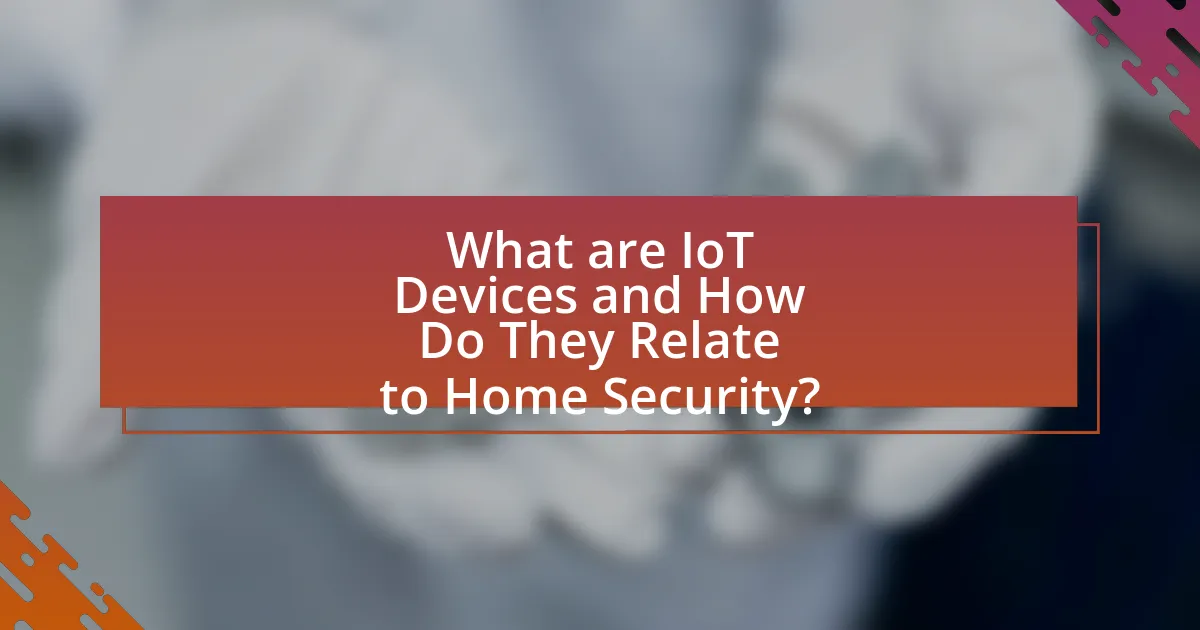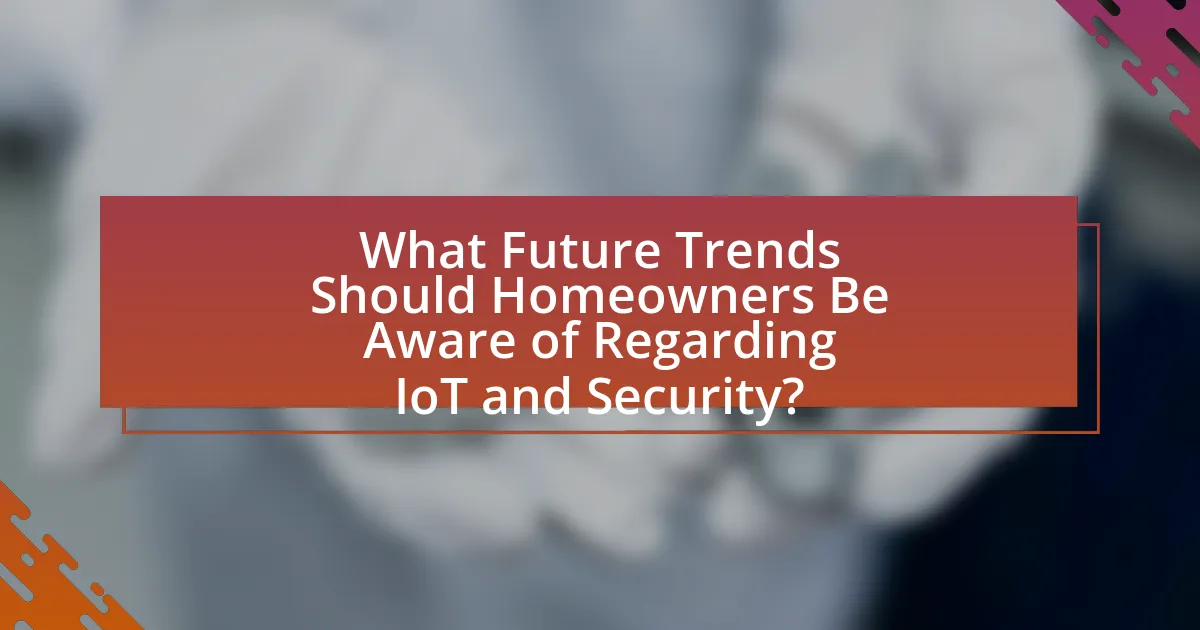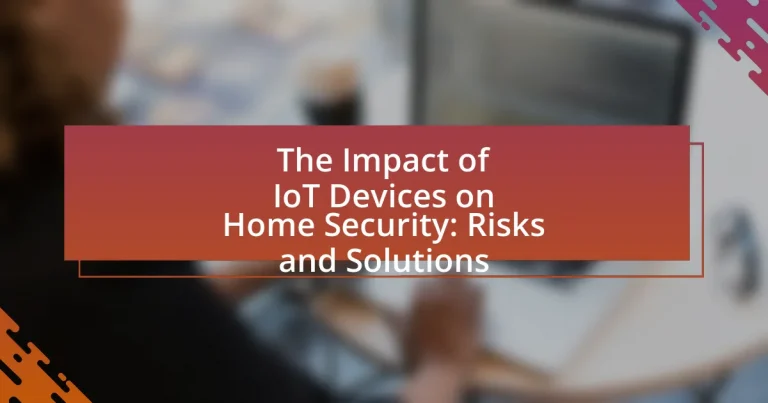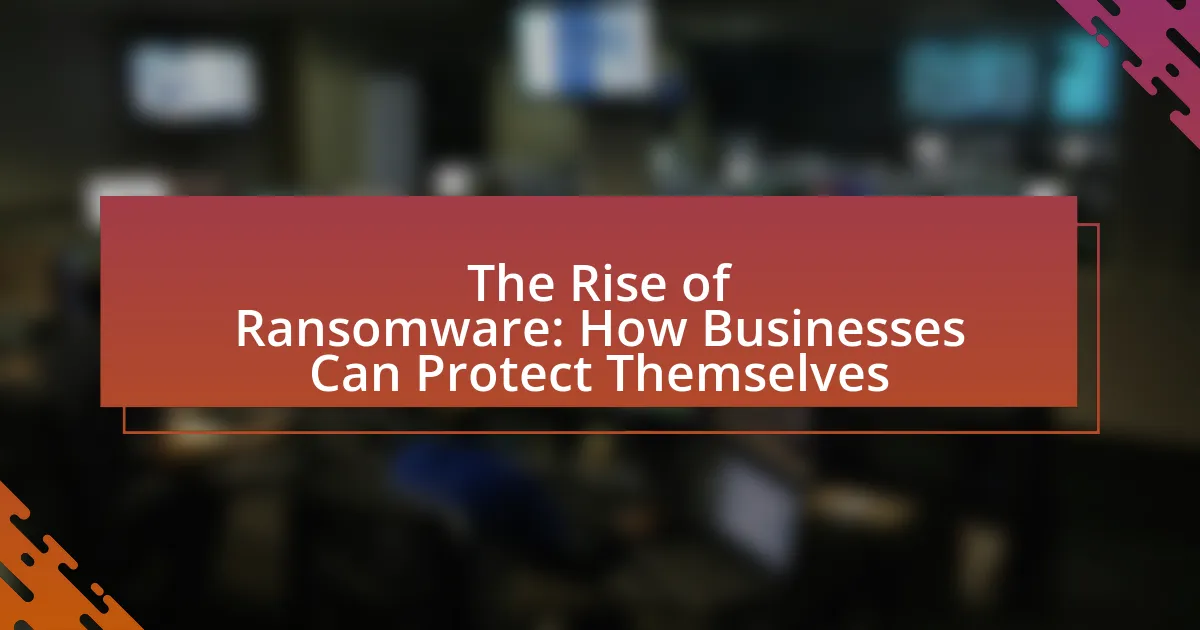The article examines the impact of Internet of Things (IoT) devices on home security, highlighting both the benefits and risks associated with their use. It details how IoT devices, such as smart cameras and locks, enhance security through real-time monitoring and remote access, while also addressing vulnerabilities that can be exploited by hackers. The discussion includes common types of IoT security devices, communication methods between them, and potential risks like data breaches. Additionally, the article outlines solutions for mitigating these risks, including strong encryption, regular software updates, and best practices for device configuration, as well as future trends in IoT technology and security regulations.

What are IoT Devices and How Do They Relate to Home Security?
IoT devices, or Internet of Things devices, are interconnected gadgets that communicate over the internet, enabling remote monitoring and control. In the context of home security, IoT devices such as smart cameras, doorbell cameras, and smart locks enhance security by providing real-time surveillance, alerts, and remote access control. According to a report by Statista, the global smart home market, which includes IoT security devices, is projected to reach $174 billion by 2025, indicating a significant trend towards integrating technology in home safety. This integration allows homeowners to monitor their properties from anywhere, receive instant notifications of suspicious activities, and manage security systems remotely, thereby improving overall home security.
How do IoT devices enhance home security systems?
IoT devices enhance home security systems by providing real-time monitoring and automation capabilities. These devices, such as smart cameras, motion sensors, and smart locks, allow homeowners to remotely access and control their security systems via smartphones or computers. For instance, a study by Statista indicates that the global smart home market, which includes IoT security devices, is projected to reach $174 billion by 2025, highlighting the growing reliance on technology for enhanced security. Additionally, IoT devices can send instant alerts to homeowners about suspicious activities, enabling quicker responses to potential threats.
What types of IoT devices are commonly used in home security?
Commonly used IoT devices in home security include smart cameras, smart locks, motion sensors, and smart alarms. Smart cameras provide real-time video surveillance and can be accessed remotely via mobile apps, enhancing monitoring capabilities. Smart locks allow homeowners to control access to their property through smartphones, offering convenience and security. Motion sensors detect movement and can trigger alerts or alarms, providing an additional layer of security. Smart alarms integrate with other IoT devices to provide comprehensive security solutions, often featuring notifications and remote control functionalities. These devices collectively enhance home security by enabling real-time monitoring, remote access, and automated alerts.
How do these devices communicate with each other?
IoT devices communicate with each other primarily through wireless protocols such as Wi-Fi, Bluetooth, Zigbee, and Z-Wave. These protocols enable devices to exchange data and commands, facilitating coordinated actions and responses within a home security system. For instance, a smart doorbell can send alerts to a smartphone via Wi-Fi when it detects motion, while Zigbee can connect various sensors and cameras to a central hub, allowing for seamless integration and monitoring. The effectiveness of these communication methods is supported by their widespread adoption in smart home technologies, enhancing both convenience and security.
What are the potential risks associated with IoT devices in home security?
The potential risks associated with IoT devices in home security include vulnerabilities to hacking, data privacy breaches, and device malfunctions. IoT devices often have weak security protocols, making them attractive targets for cybercriminals who can exploit these weaknesses to gain unauthorized access to home networks. For instance, a study by the University of California, Berkeley, found that 70% of IoT devices are susceptible to attacks due to inadequate security measures. Additionally, these devices collect and transmit sensitive personal data, which can be intercepted or misused if proper encryption is not implemented. Furthermore, reliance on IoT devices can lead to significant security risks if they malfunction or are improperly configured, potentially leaving homes unprotected.
How can vulnerabilities in IoT devices be exploited by hackers?
Vulnerabilities in IoT devices can be exploited by hackers through various methods, including unauthorized access, data interception, and remote control. Hackers often target weak default passwords, unpatched software, or insecure communication protocols to gain control over these devices. For instance, a study by the Cybersecurity & Infrastructure Security Agency (CISA) highlighted that many IoT devices lack adequate security measures, making them susceptible to attacks such as Distributed Denial of Service (DDoS) or data breaches. In 2016, the Mirai botnet attack demonstrated how compromised IoT devices could be used to launch large-scale attacks, affecting millions of users and highlighting the critical need for improved security in IoT ecosystems.
What are the implications of data breaches in home security systems?
Data breaches in home security systems can lead to unauthorized access to personal information and physical properties. When hackers exploit vulnerabilities in these systems, they can gain sensitive data such as passwords, security codes, and even live feeds from cameras, which can facilitate criminal activities like burglary or identity theft. According to a 2021 report by the Identity Theft Resource Center, there was a 17% increase in data breaches compared to the previous year, highlighting the growing risk associated with IoT devices, including home security systems. This breach not only compromises individual safety but also erodes trust in security technology, potentially leading to decreased adoption of smart home solutions.

What Solutions Exist to Mitigate Risks of IoT Devices in Home Security?
To mitigate risks of IoT devices in home security, implementing strong encryption protocols is essential. Encryption protects data transmitted between devices and prevents unauthorized access. Additionally, regularly updating device firmware addresses vulnerabilities, as manufacturers often release patches for security flaws. Utilizing a secure home network, such as a separate Wi-Fi network for IoT devices, limits exposure to potential threats. Employing multi-factor authentication adds an extra layer of security, ensuring that even if credentials are compromised, unauthorized access is still prevented. According to a report by the Cybersecurity & Infrastructure Security Agency, these measures significantly reduce the likelihood of successful cyberattacks on IoT systems.
How can homeowners secure their IoT devices?
Homeowners can secure their IoT devices by implementing strong, unique passwords for each device and regularly updating them. This practice significantly reduces the risk of unauthorized access, as weak or default passwords are a common vulnerability. According to a 2021 report by the Cybersecurity & Infrastructure Security Agency, 85% of data breaches involve weak or stolen passwords. Additionally, homeowners should ensure that their devices are running the latest firmware, as updates often include security patches that protect against known vulnerabilities. Enabling network encryption and using a separate guest network for IoT devices further enhances security by isolating them from primary devices.
What best practices should be followed for device configuration?
To ensure optimal device configuration, users should follow best practices such as changing default passwords, enabling encryption, and regularly updating firmware. Changing default passwords mitigates unauthorized access, as many devices come with easily guessable credentials. Enabling encryption protects data transmitted between devices, making it difficult for attackers to intercept sensitive information. Regularly updating firmware addresses vulnerabilities, as manufacturers often release patches to fix security flaws. These practices collectively enhance the security posture of IoT devices, reducing the risk of breaches and ensuring a safer home environment.
How important is regular software updating for IoT devices?
Regular software updating for IoT devices is crucial for maintaining security and functionality. These updates often include patches for vulnerabilities that could be exploited by cybercriminals, thereby reducing the risk of unauthorized access and data breaches. For instance, a report by the Cybersecurity & Infrastructure Security Agency (CISA) highlighted that outdated software is a primary vector for cyberattacks on IoT devices. Regular updates ensure that devices are equipped with the latest security measures, thus protecting home networks and sensitive information from potential threats.
What role do manufacturers play in ensuring device security?
Manufacturers play a critical role in ensuring device security by implementing robust security measures during the design and production phases of IoT devices. They are responsible for integrating security features such as encryption, secure boot processes, and regular firmware updates to protect against vulnerabilities. For instance, a study by the Internet of Things Security Foundation highlights that devices with built-in security protocols are significantly less likely to be compromised, demonstrating the effectiveness of proactive security measures. Additionally, manufacturers must adhere to industry standards and regulations, which further reinforces the security of their products.
What security features should consumers look for in IoT devices?
Consumers should look for robust security features in IoT devices, including end-to-end encryption, secure boot processes, regular firmware updates, and strong authentication methods. End-to-end encryption ensures that data transmitted between the device and the user is protected from interception, while secure boot processes prevent unauthorized software from running on the device. Regular firmware updates are crucial for patching vulnerabilities, as evidenced by a report from the Cybersecurity & Infrastructure Security Agency, which states that 85% of IoT device vulnerabilities can be mitigated through timely updates. Strong authentication methods, such as two-factor authentication, add an additional layer of security by requiring more than just a password to access the device. These features collectively enhance the overall security posture of IoT devices, making them safer for consumer use.
How can manufacturers improve the security of their products?
Manufacturers can improve the security of their products by implementing robust encryption protocols and regular software updates. Encryption protects data transmitted between devices, making it difficult for unauthorized users to access sensitive information. Regular software updates address vulnerabilities and enhance security features, as evidenced by a study from the University of California, which found that 80% of IoT device breaches were due to outdated software. By prioritizing these measures, manufacturers can significantly reduce the risk of security breaches in their products.

What Future Trends Should Homeowners Be Aware of Regarding IoT and Security?
Homeowners should be aware that future trends in IoT and security will increasingly focus on enhanced interoperability, advanced AI-driven security systems, and improved data privacy measures. Interoperability among devices will allow for seamless integration, enabling homeowners to manage multiple IoT devices from a single platform, which can enhance security monitoring. AI-driven systems will utilize machine learning to detect anomalies and potential threats in real-time, significantly improving response times and threat identification. Additionally, as data privacy concerns grow, regulations such as the General Data Protection Regulation (GDPR) will push manufacturers to adopt stricter data protection measures, ensuring that user data is safeguarded against breaches. These trends indicate a shift towards more secure, efficient, and user-friendly IoT home security solutions.
How is the landscape of home security evolving with IoT technology?
The landscape of home security is evolving significantly due to IoT technology, which enhances connectivity and automation in security systems. IoT devices, such as smart cameras, door locks, and alarm systems, allow homeowners to monitor and control their security remotely via smartphones or other devices. According to a report by MarketsandMarkets, the global smart home security market is projected to grow from $47.6 billion in 2020 to $82.3 billion by 2025, indicating a strong trend towards the adoption of IoT in home security. This evolution not only improves convenience and real-time monitoring but also introduces challenges such as cybersecurity risks, as these devices can be vulnerable to hacking if not properly secured.
What advancements in IoT technology are expected to enhance security?
Advancements in IoT technology expected to enhance security include the implementation of advanced encryption protocols, AI-driven threat detection, and improved device authentication methods. Advanced encryption protocols, such as AES-256, protect data transmitted between devices, making it significantly harder for unauthorized users to intercept sensitive information. AI-driven threat detection systems analyze patterns and behaviors in real-time, allowing for the identification of potential security breaches before they occur. Additionally, improved device authentication methods, including biometric verification and multi-factor authentication, ensure that only authorized users can access IoT devices, thereby reducing the risk of unauthorized access. These advancements collectively contribute to a more secure IoT ecosystem, addressing vulnerabilities that have been historically exploited.
How might regulations impact the use of IoT devices in home security?
Regulations can significantly impact the use of IoT devices in home security by establishing standards for data privacy, security protocols, and interoperability. For instance, regulations like the General Data Protection Regulation (GDPR) in Europe mandate strict data handling practices, compelling manufacturers to enhance security features in their devices to protect user information. Additionally, compliance with regulations can lead to increased costs for manufacturers, which may affect the pricing and availability of IoT security solutions in the market. Furthermore, regulations can foster consumer trust by ensuring that devices meet specific safety and security benchmarks, ultimately influencing consumer adoption rates of IoT home security systems.
What practical steps can homeowners take to stay informed and secure?
Homeowners can stay informed and secure by regularly updating their IoT device firmware and utilizing strong, unique passwords for each device. Keeping firmware updated ensures that any security vulnerabilities are patched, as manufacturers often release updates to address potential threats. According to a 2021 report by the Cybersecurity & Infrastructure Security Agency, 85% of IoT device vulnerabilities can be mitigated through regular updates. Additionally, employing strong, unique passwords reduces the risk of unauthorized access; a study by the Ponemon Institute found that 63% of data breaches are linked to weak passwords. Homeowners should also enable two-factor authentication where available, monitor device activity, and educate themselves about the latest security threats related to IoT devices.
How can homeowners educate themselves about IoT security risks?
Homeowners can educate themselves about IoT security risks by actively researching and understanding the vulnerabilities associated with connected devices. They should read reputable sources such as cybersecurity blogs, government publications, and industry reports that detail common threats and best practices for securing IoT devices. For instance, the Cybersecurity & Infrastructure Security Agency (CISA) provides guidelines on securing IoT devices, highlighting the importance of changing default passwords and keeping firmware updated. Additionally, homeowners can participate in online forums and community discussions focused on IoT security to share experiences and learn from others. Engaging with educational resources, such as webinars and workshops offered by cybersecurity organizations, can further enhance their knowledge and preparedness against potential risks.
What resources are available for ongoing IoT security education?
Ongoing IoT security education resources include online courses, webinars, industry certifications, and professional organizations. Platforms like Coursera and edX offer specialized courses on IoT security, while organizations such as the Internet of Things Security Foundation provide webinars and whitepapers. Additionally, certifications from CompTIA and ISC² focus on IoT security principles, enhancing professional knowledge. These resources are essential for staying updated on evolving threats and best practices in IoT security.




